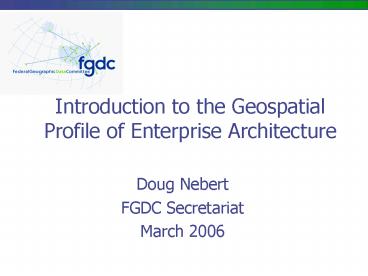Introduction to the Geospatial Profile of Enterprise Architecture - PowerPoint PPT Presentation
1 / 12
Title:
Introduction to the Geospatial Profile of Enterprise Architecture
Description:
Defines a framework in which one describes the current and future work ... to develop consistent methodology to call-out geospatial elements of all aspects ... – PowerPoint PPT presentation
Number of Views:74
Avg rating:3.0/5.0
Title: Introduction to the Geospatial Profile of Enterprise Architecture
1
Introduction to the Geospatial Profile of
Enterprise Architecture
- Doug Nebert
- FGDC Secretariat
- March 2006
2
Enterprise Architecture
- Defines a framework in which one describes the
current and future work activities and justifies
the investments (personnel, data, applications)
of an enterprise - A precursor to electronic government (e-gov) and
business process re-engineering
3
FEA Reference Models
- Business Reference Model (BRM) define
mission-critical lines of business, business
processes, and functions - Performance Reference Model (PRM) developed to
define measures of business performance - Technical Reference Model (TRM) identifies and
describes the technology (components, interfaces)
used to achieve the BRM - Service Reference Model (SRM) defines the types
and instances of services required to support
processes - Data Reference Model (DRM) defines the
data/information concepts, structures,
definitions, and values or enumerations required
by the BRM in the context of the TRM
4
Describing the Enterprise
mission
5
Requirements for Geospatial Profile in Enterprise
Architecture
- Geographic information is used in a majority of
business settings in and outside of government - Geographic information and services are not
addressed consistently within and between
organizations - Interoperability among providers and consumers of
geographic data and services requires a common
understanding of semantics and functional
capabilities - Development of common multi-jurisdictional
approaches to the use of geographic information
and services requires inclusion in Enterprise
Architecture
6
Solution Creation of guidance for geospatial
capabilities in the FEA
- Develop a Geospatial Profile document for the FEA
to support its cross-cutting nature, along the
lines of the Profiles being developed for Records
Management and Security and Privacy - Deploy the concept outside the bounds of FEA to
include local and state government
7
FEA Geospatial Profile
- Companion to Federal Enterprise
Architecture (FEA) Reference Models
to recognize and promote the pervasive
nature of geospatial capabilities in lines of
business across government - Audience Agency chief architects and CIO staff
in federal, state, or local government - Objective to develop consistent methodology to
call-out geospatial elements of all aspects of
government business - Format 60 page document with many resource
annexes
8
Agencies
Economic Development
Community and Social Services
Financial Management
Human Resources
Natural Resources
Homeland Security
Health
Education
Geospatial
Profiles
Security Privacy
Records Management
Lines of Business
9
Geospatial Profile Outline
- Data Reference Model
- Service Components Reference Model
- Technology Reference Model
- Performance Reference Model and Maturity Model
- Appendix A References
- Appendix B Glossary
- Appendix C FEA Overview
- Appendix D Use Case and Scenarios
- Appendix E Geospatial Activity Examples for BRM
- Appendix F Geospatial Business Language
- Appendix G Geospatial Service Components
- Appendix H Geospatial Standards List
- Appendix I Acronym List
- Executive Summary
- Introduction to the Geospatial Profile
- Objectives
- Audience
- Document Structure
- Introduction to Geospatial Concepts
- Cross-cutting nature of geospatial
- Overview of Geospatial Capabilities
- The NSDI
- Business Reference Model
10
Next Steps
- Working on revised outline and content for
Version 2.0 to be completed later in 2006 based
on comments received through AIC/FEA PMO - Conduct pilot project in two phases
- Interpretation of Profile by IT/business staff in
several organizations new to the document - Implementation pilot of identified capabilities
of common re-use potential among agencies
11
Pilot of Geospatial EA Principles
- Pilot activity is proposed to interpret and
deploy resources following the Geospatial Profile
to support specific mission requirements using
multiple-agency data and services - Interpret Profile in context of a common
emergency management scenario with local, state,
and federal players - Build on existing capabilities and commitments
- Establish maintainable/sustainable capability
- Provide comment back to Profile and FEA processes
- Kick-off sessions to be held in April 2006
- Pilot will include North Carolina,
Recreation.gov, and other projects
12
Initiative contact
- For more information contact
- Doug Nebert (ddnebert_at_fgdc.gov)
- (703) 648-4151































